Streets Ahead Interview: Cara Gallardo Weil
This week we are extremely honored to feature Cara Gallardo Weil in this segment of “Streets Ahead.” We previously interviewed Cara in our A Day In The Life Of Interview, see here.
Cara is a Graphic Designer and amateur photographer with a passion for mobile photography. Born in Hong Kong to Filipino parents who moved there in the early 60s to work in publishing, her early life was spent in Hong Kong, Singapore and the Philippines. She studied graphic design in London and spent more than 20 years here before returning to Hong Kong, where she currently resides.
Cara brings to her street photography a wonderful international and cultural perspective. Her work has been exhibited and featured in many different galleries and magazines throughout the world, and recently she was showcased in Hipstamatic’s popular magazine “Snap.”
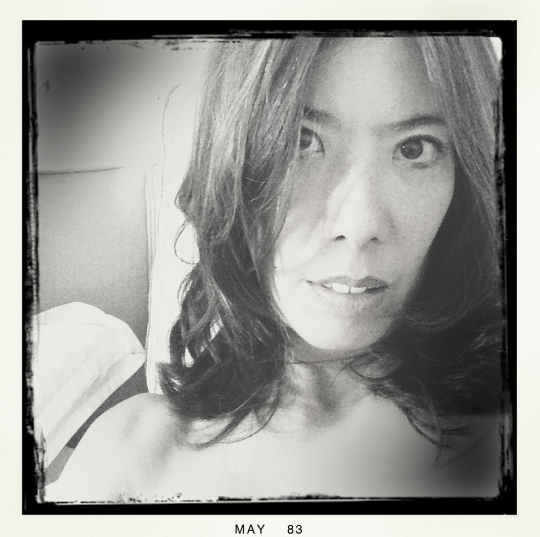
© Cara Gallardo Weil
Please share a little bit about yourself…
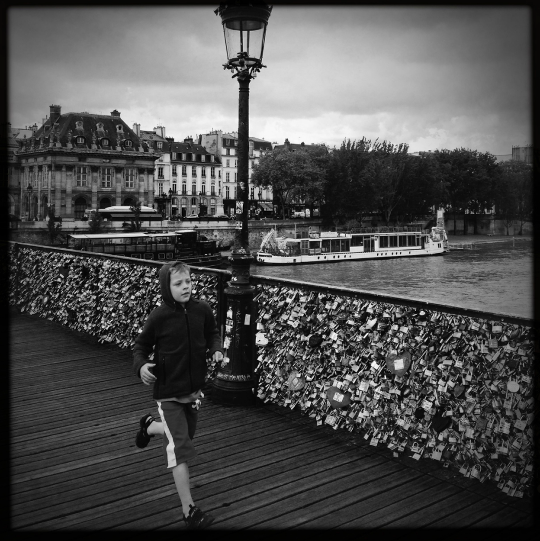
© Cara Gallardo Weil, “Pont des Arts”
Can you tell us a little about yourself? Where are you from? Have you always been interested in photography? Are you (or have you been) involved in any other art medium… such as painting, sculpture, writing, music?
I am from the Philippines originally but I was born in Hong Kong and spent the early part of my childhood in Singapore, Hong Kong and the Philippines. I finished high school in Hong Kong and went to study graphic design in London.
I have always been interested in photography and was given my “first grown up” camera when I was 16, by a very good friend of my parents who was a professional photographer. It was a Nikon (I don’t remember which model) but it proved to be extremely useful because one of the subjects that we covered in my design course was photography. Apart from dabbling in painting, drawing, sculpture and writing at school and art college, I haven’t been involved in any other art medium as I’ve always been more ‘technical’, hence the decision to study graphic design.
Which mobile device do you use?
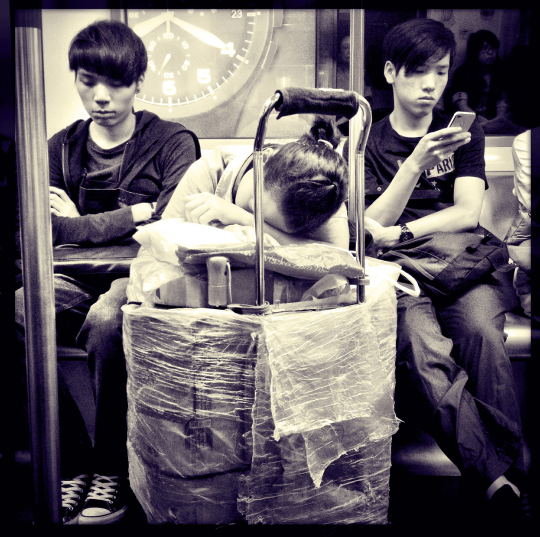
© Cara Gallardo Weil, “Asleep”
Which mobile device do you use to take (and process) your photographs?
I use an iPhone 4s and iPhone 5. I also have an iPad which I sometimes use for processing.
How did it all start?
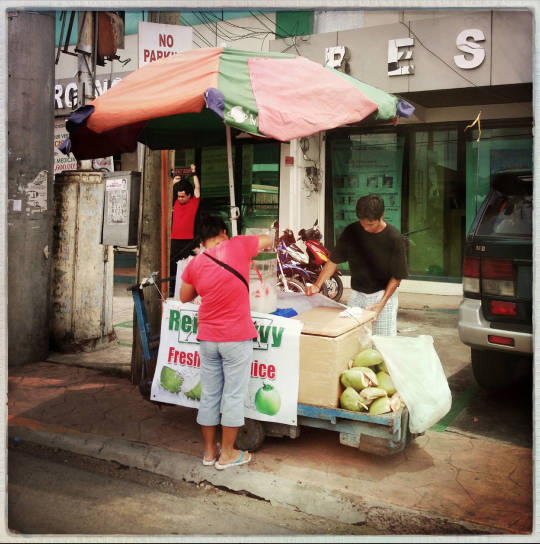
© Cara Gallardo Weil, “Buko Juice”
How did you get involved in mobile street photography? And is this a genre that you predominantly focus on in your work?
I stumbled in to street photography. I never used to take photographs with people in them, ‘I would always wait for the ’empty’ moments. I remember visiting Beijing in the early days of my love affair with hipstamatic and the iPhone and I would purposely take photographs of places where there were no people, or maybe one person at the most. Of course in places like the Great Wall and the Forbidden City it is virtually impossible to take photographs with no people. I think shooting with the iPhone changed my approach to photographing things around me. Because I was shooting so much and it suddenly became about capturing moments, I naturally fell in to the genre. I was also invited to join a Facebook group, and the focus was street photography. It made a huge difference being a part of that group, and learning from the other members.
On looking at my work, it does appear to be a genre that I focus on, but it is not intentional. The amount of travel that I do means I am frequently in a different city, and inevitably what I shoot is from the street.
Street Photography Ethics…
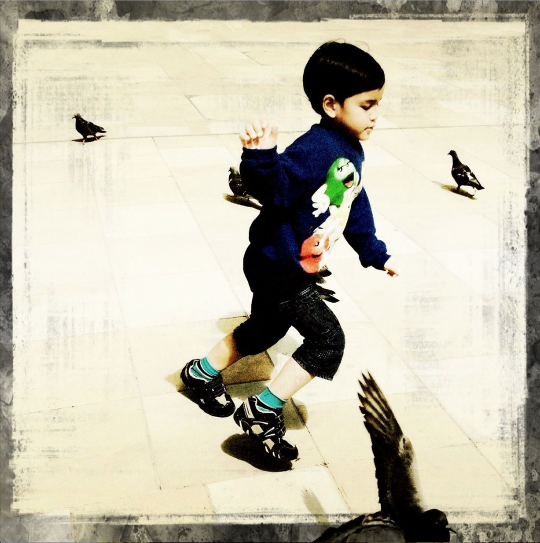
© Cara Gallardo Weil, “Chasing Birds”
There is a general question among some people about the morals and ethics of taking pictures of strangers in a public environment. Many think that this is an infringement of an individual’s rights and privacy. What are your thoughts on this? Has the question about “privacy” been an issue for you in your work? Have you had any negative experiences taking street photographs in your home country or whilst traveling abroad? How did you handle them?
I can understand the issue about privacy and I am often asked whether I think its odd to be taking photographs of strangers. It is a complex subject. I did a photography course recently and my tutor told me that he didn’t think it was right to take photographs of anyone disabled or handicapped and mainly because they often will not have choice to turn away if they catch you taking a shot. I was once punched in the arm for taking a photograph of a man selling birds made from bamboo in Lan Kwai Fong, which is a very touristy part of Hong Kong. Apparently he had a sign that I didn’t see which states ‘no photo $100’; ie you had to pay him $100 Hong Kong dollars if you wanted to take a photo of him. A bit mad because it is not illegal to take photos in a public place in Hong Kong, so he shouldn’t really be asking for money. I also thought that stationing himself in a very touristy area was virtually an open invitation to take a photograph, given that he was an unusual looking character anyway.
However there is indeed a big question on the ethics of street photography. Eric Kim has some good advice on this in an interview that he did recently with the BBC http://www.bbc.co.uk/religion/0/21532400
Personal guidelines while in the streets…
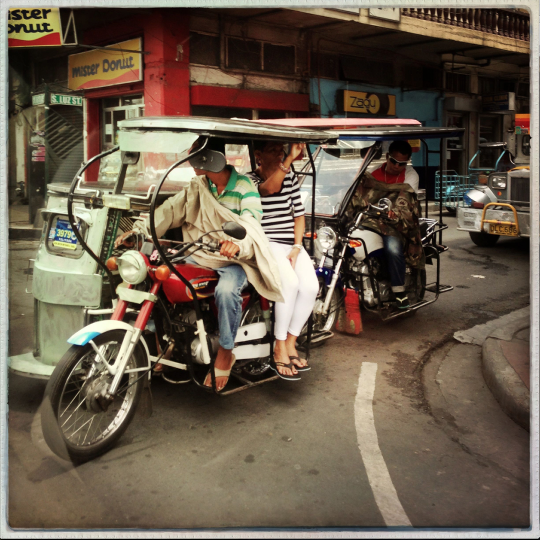
© Cara Gallardo Weil, “Side Saddle”
Do you have any rules in place when you are on the street photographing? For example: are there certain “things” or situations that you personally feel are “off limits” in your photography? Can you explain why?
I don’t like to be too intrusive; this is my general rule, which probably goes against the grain of traditional street photography. There are many who say that a good street photograph must be one where you can see the persons face and not their back, or only their legs, not looking down, away, or wearing sunglasses. I find this school of thought so restrictive. And in that respect, I am not ‘traditional’ street photographer. There are also some that say a street photograph should not be posed, and generally, I would probably agree with this. But there are some instances, especially in a place like the Philippines, where people love having their photo taken and they can’t help but pose sometimes. Personally I just follow my instinct and don’t worry too much about the ‘rules’. At the end of the day, if I like the photograph, I’m happy. And if someone else likes it too, that is even better.
After what my photography tutor said I tend to not to shoot photos of anyone disabled or handicapped. In Hong Kong there are a lot of beggars who are disabled and I used to occasionally take shots of them, but I don’t do it anymore.
Personal preferences while on a photo shoot…
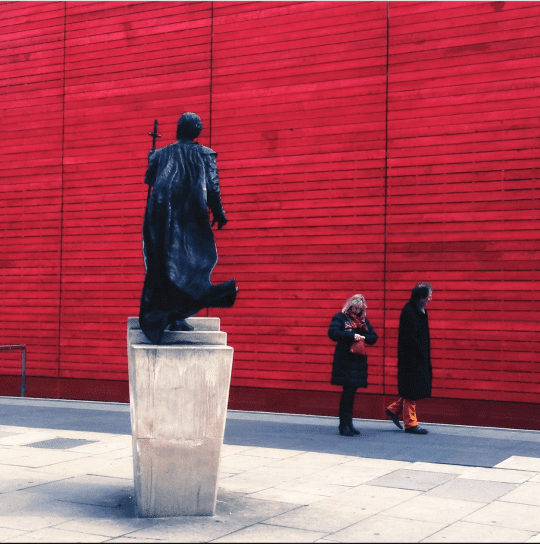
© Cara Gallardo Weil, “Sir Laurence”
What kind of situations, characters, and/or environments appeal to you? Why?
In the day to day bustle of cities like Hong Kong or London, I like to capture unusual characters or interesting juxtapositions. I travel a fair amount and I like to spend time walking everywhere if possible. I’m open to all environments, except perhaps big crowds because I feel too claustrophobic in situations like that.
Women’s perspective in street photography…

© Cara Gallardo Weil, “Sightseeing”
Do you think that women bring to photography, especially street photography, a certain perspective that is not necessarily shared by many male photographers? If so, can you elaborate on your thoughts?
I look at street photography all the time, from men and women and I’m not sure there is a difference in perspective and I’m sure there will be some who disagree with me, but personally, when shooting street, I believe that we all try to capture the moments or a photo that tells a story. I will say that perhaps men are probably braver and women are more discreet but that is probably more a reflection of my style of shooting.
Women street photographers who have influenced you…

© Cara Gallardo Weil, “Who are you looking at?”
Are there any women street photographers/photojournalists who have inspired you in your work? If so, who are they? And what inspires you about their work?
One cannot possibly talk about women street photographers without mentioning Vivian Maier. She was an American amateur street photographer who worked as a nanny in Chicago for approximately 40 years, during which time she took more than 100,000 photographs. These remained unknown and mostly undeveloped when the boxes of negatives were discovered by John Maloof at a local thrift auction house in Chicago in 2007. She was intensely private and unknown as a photographer in her lifetime. Her photographs are absolutely amazing to say the least and I would like to aspire to be as brave as she was. She used a Rolleiflex, which of course is much more visible than an iPhone. But perhaps in those days people were a bit more open to cameras? There appears to be more issues about privacy and security these days, especially since 9/11.
Other women street photographers and photo journalists that I admire are Dorothea Lange, Lee Miller and Ruth Orkin. Dorothea Lange was best known for her work during the Great Depression. Lee Miller worked primarily in fine art and fashion but during the Second World War she covered the Blitz in London the liberation of Paris and the concentration camps at Buchenwald and Dachau. Ruth Orkin was a photojournalist and filmmaker and was a contributor to Life magazine.
Role that mobile devices play with women and photography…
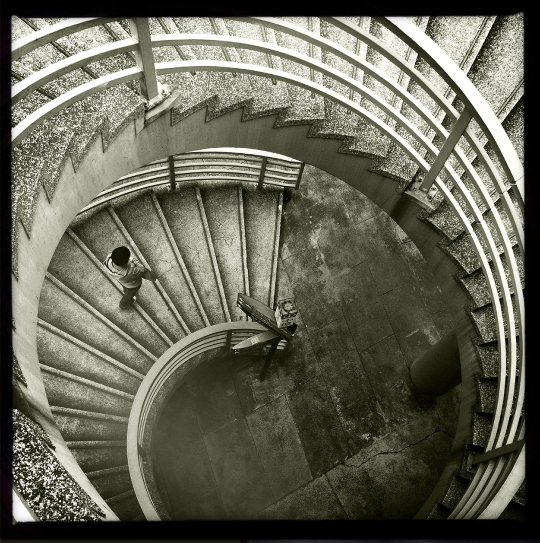
© Cara Gallardo Weil, “Spiral”
Do you think that more women are getting involved in this genre because of the democracy and immediacy of mobile devices? What are your thoughts on this?
I think the immediacy of mobile devices has enabled many people, men as well as women to explore the creative side of themselves. And I do believe that the ability to be stealth and discreet with a mobile device has encouraged many more people to get involved with the genre. I certainly would never have discovered it for myself if it hadn’t been for the iPhone. I’ve always loved street photography, but more as a viewer rather than actually being the person taking the photographs.
Post processing images…
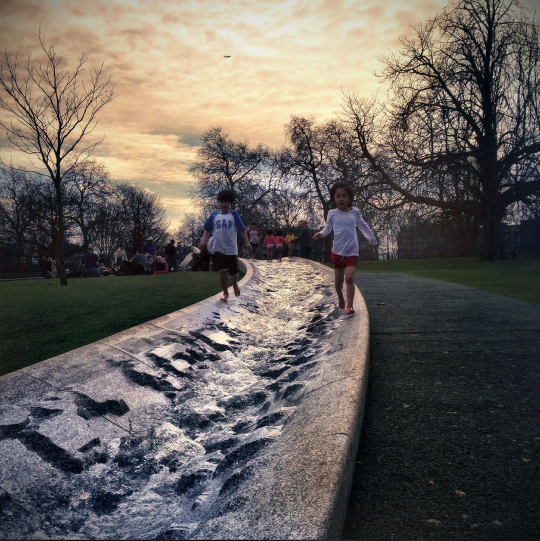
© Cara Gallardo Weil, “Diana Memorial Hyde Park” (Original image shot with Hipstamatic using the Foxy lens/Sugar film combo and no flash. I used Snapseed to brighten, straighten and crop the image. Then I used XnViewFX and used the ‘Pumpkin’ filter under ‘tint’ and lastly, I added a vignette.)
What are your thoughts on post-processing mobile street images? Do you post process your own images? Can you share with us an example of your workflow process?
I have no issue with post-processing mobile street images. Personally, sometimes I post process and sometimes I do not. It just depends on the image and whether I feel it needs extra processing. I tend to shoot every image with hipstamatic and if I feel that it needs something more, I will do some post-processing. Hipstamatic’s new app, Oggl is great and if you are a hipstamatic fan and haven’t tried Oggl yet, you might want to give it a go and the app enables you to change the film and lens combination after you taken the shot. I use Snapseed for straightening and cropping images, and XnViewFX for adding more filters. Touch ReTouch is good for editing out anything that you don’t want in the image. Other go-to apps are ProCreate, Laminar, Photocopier, BlurFX and PhotoToaster.
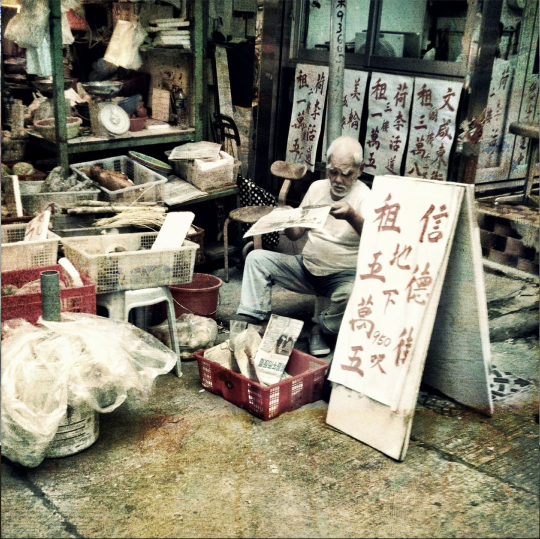
© Cara Gallardo Weil, “Morning Paper” (Original image shot with Hipstamatic, Wonder lens/Inas 1982 film combo and no flash. I imported the image into XnViewFX and used the ‘Butter Cream’ filter. Then I used Snapseed to brighten the image under ‘selective adjusts’. Then I imported the image into Laminar and used the ‘Grunge’ filter under the ‘Vintage’; options. I used the slider to adjust the amount of grunge. Then, because I thought it looked too grungy, I blended the grunge image with the previous image using Image Blender. Lastly, I brought it back in to Snapseed and cropped the image.)
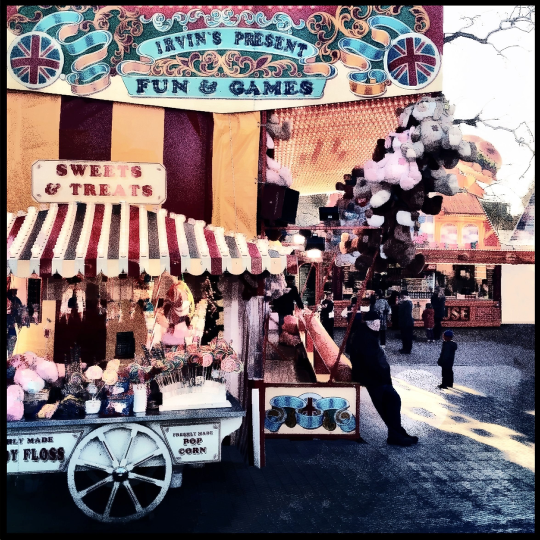
© Cara Gallardo Weil, “Fun and Games” (I am struggling to remember exactly what I did with this image! The original was shot with hipstamatic, then imported in to iColorama and where I used the ‘Painterly’ filter under the ‘Style’ option. Then I imported the image into Etchings and used one of those filters. I used Image blender to combine the etched image with the painterly image. Then I used Snapseed to straighten and crop the image and lastly I added a thin black border using PicFrame.)
Please share some images and what your thoughts about them are…
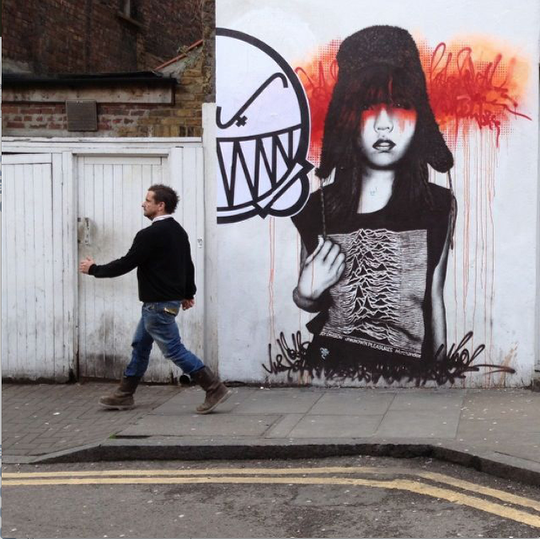
© Cara Gallardo Weil, “Brick Lane: Unknown Pleasures”
Can you share with us a few of your images that you feel give us good overview of your work… we’d love to hear what you were thinking or felt when you took these photographs. What moved you?
Brick Lane, “Unknown Pleasures: When I’m in London I often go to Brick Lane to get some bagels (they are freshly baked and just divine). The added bonus is that one often finds a lot of street art as well as interesting characters. I was drawn to this particular piece by street artist Fin DAC because the girl is wearing a t-shirt with the album cover artwork from Joy Division and Unknown Pleasures. When I left art college I worked for graphic designer Peter Saville who designed this and other Joy Division and New Order record sleeves. The first job I worked on was some artwork for a New Order single, so it has great memories for me. I took several shots of people walking by, but this one worked best as he was just to the side of the art and not in front.)

© Cara Gallardo Weil, “Child hitching a ride”
This was probably one of the first shots I took that really made me think more seriously about street photography. I had just started using the iPhone for street shots and it was perfect for capturing this particular one. I noticed her as we were waiting to cross the street. She was sitting on her father’s trolly and she had such a classic look about her ‘almost old fashioned’; it was a split second decision but I’m glad that I caught her.
Artistic goals and aspirations…
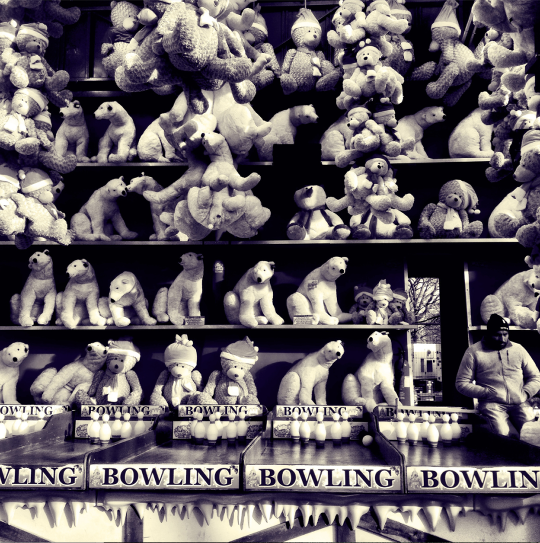
© Cara Gallardo Weil, “Polar bears and bowling” (We were at a Christmas fair in Hyde Park in London last year and I noticed this huge wall of stuffed toys. As it was quite early on in the day, most of the stalls were still fairly empty and the man running this one looked really bored. I was actually just trying to capture the immensity of the wall but when I looked at the image later, I noticed him in the corner. I quite like that he is squeezed right in to the corner; you don’t notice him at first, but then you see him and it is quite an odd juxtaposition.)
What are your artistic goals and aspirations?
I would like to try to be braver when it comes to street photography. And although I love shooting with the iPhone, I would also like to find time to master shooting with my ‘big cameras’; (I have an Olympus OMD and a Leica D-Lux 4).
Social Media platforms…
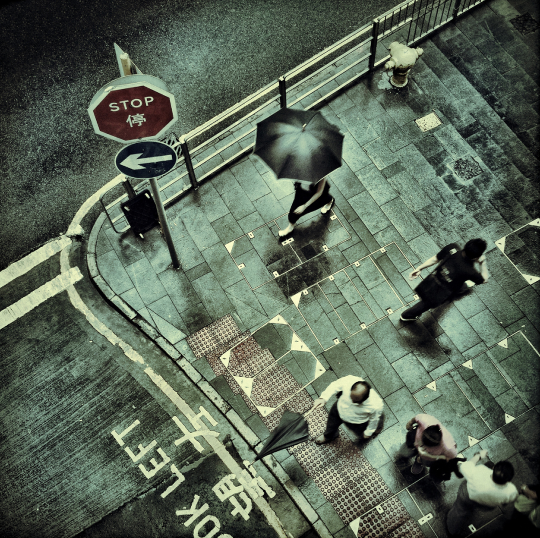
© Cara Gallardo Weil, “Bird’s Eye View” (We have many pedestrian walkways in Hong Kong and I love taking photos of the city bustle from various elevated viewpoints. I like the shapes created by umbrellas and this particular shot has one open and one shut, but pointing forward it creates an interesting street scene.)
Where do you show your work? What social networks are you on? On which platforms are you most involved?
I post mainly on Facebook, Instagram and Oggl. I sometimes post on Flickr, IPA, Eye’Em and 500px. I use Facebook the most.
Personal tips…
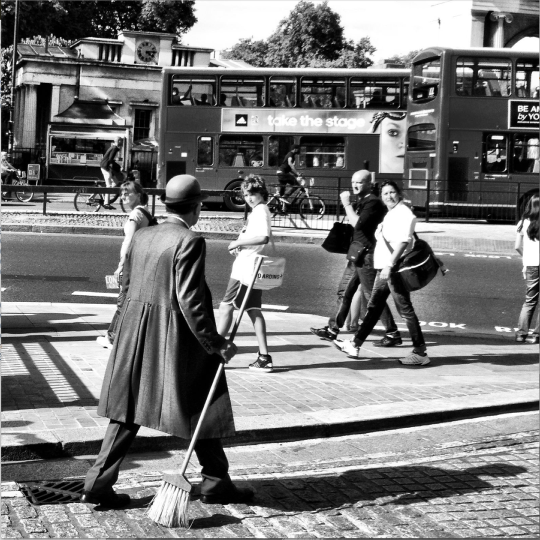
© Cara Gallardo Weil, “Hyde Park Corner” (This scene is just outside the Lanesborough Hotel which is on Hyde Park corner in London. The doorman almost looks like he could be a chimney sweep from the Victorian era (although he does look a bit too well dressed to be working with sooty chimneys). I like that I caught the boy looking back at him as if he was trying to figure him out.)
Do you have any mobile street photography tips or tricks that you’d like to share with us?
Be fast. Don’t think too much, or worry too much about composition as you may miss the moment. Try to see beyond your normal field of vision so that you see potential moments coming up. Shoot from wherever you are, even if you are behind glass in a car. Sometimes you have to wait for the moments. I was once with Clay Butch Benskin in New York and was able to watch him operate. He waits until people are unaware and comfortable enough not to notice him and then he captures the moment. His work is stellar and I take great inspiration from him.
Anything else?
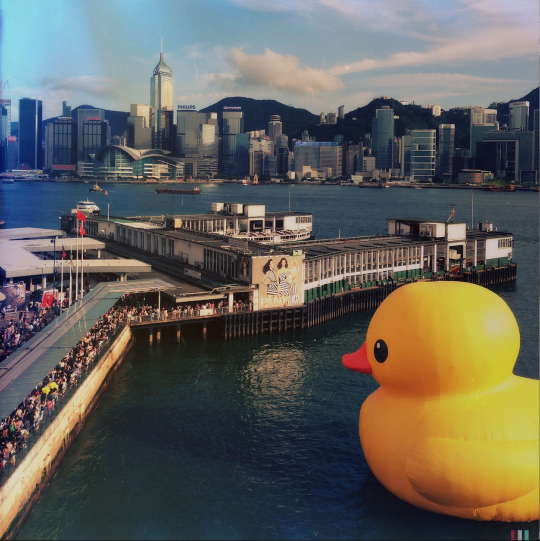
© Cara Gallardo Weil, “The duck’s point of view”
Is there anything else that you would like to share with us?
I would like to thank JQ Gaines for asking me to do this interview and of course Joanne Carter for continuing to be a great support for the mobile photography community. I am grateful to be a part of it and to be able to learn from all the wonderful talent out there!
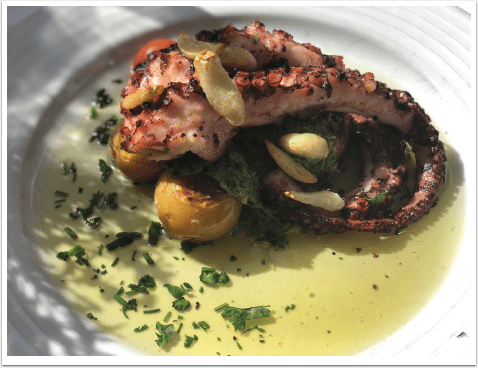
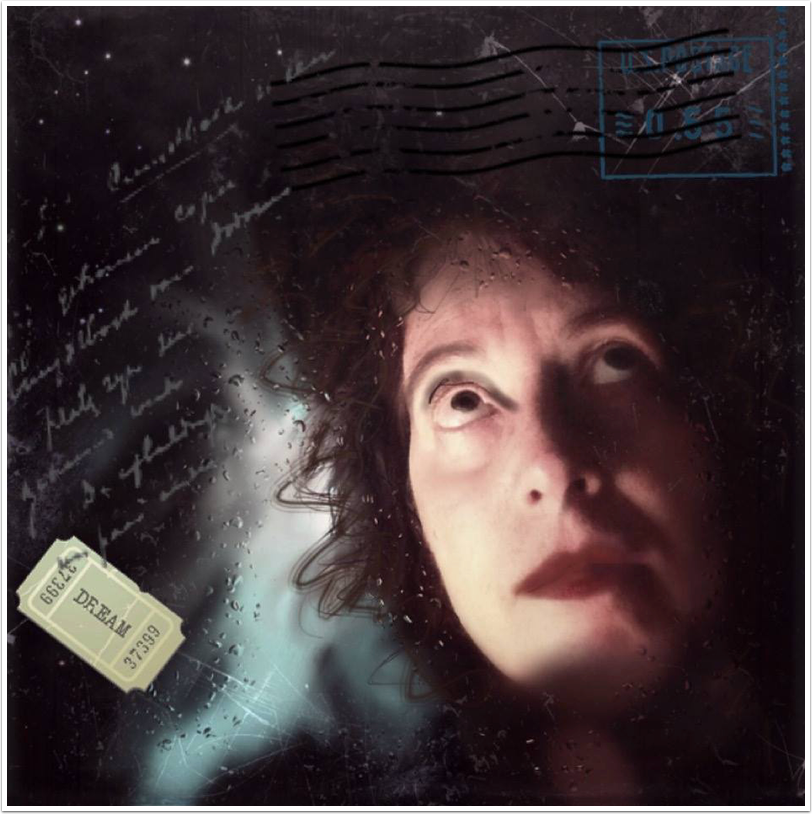
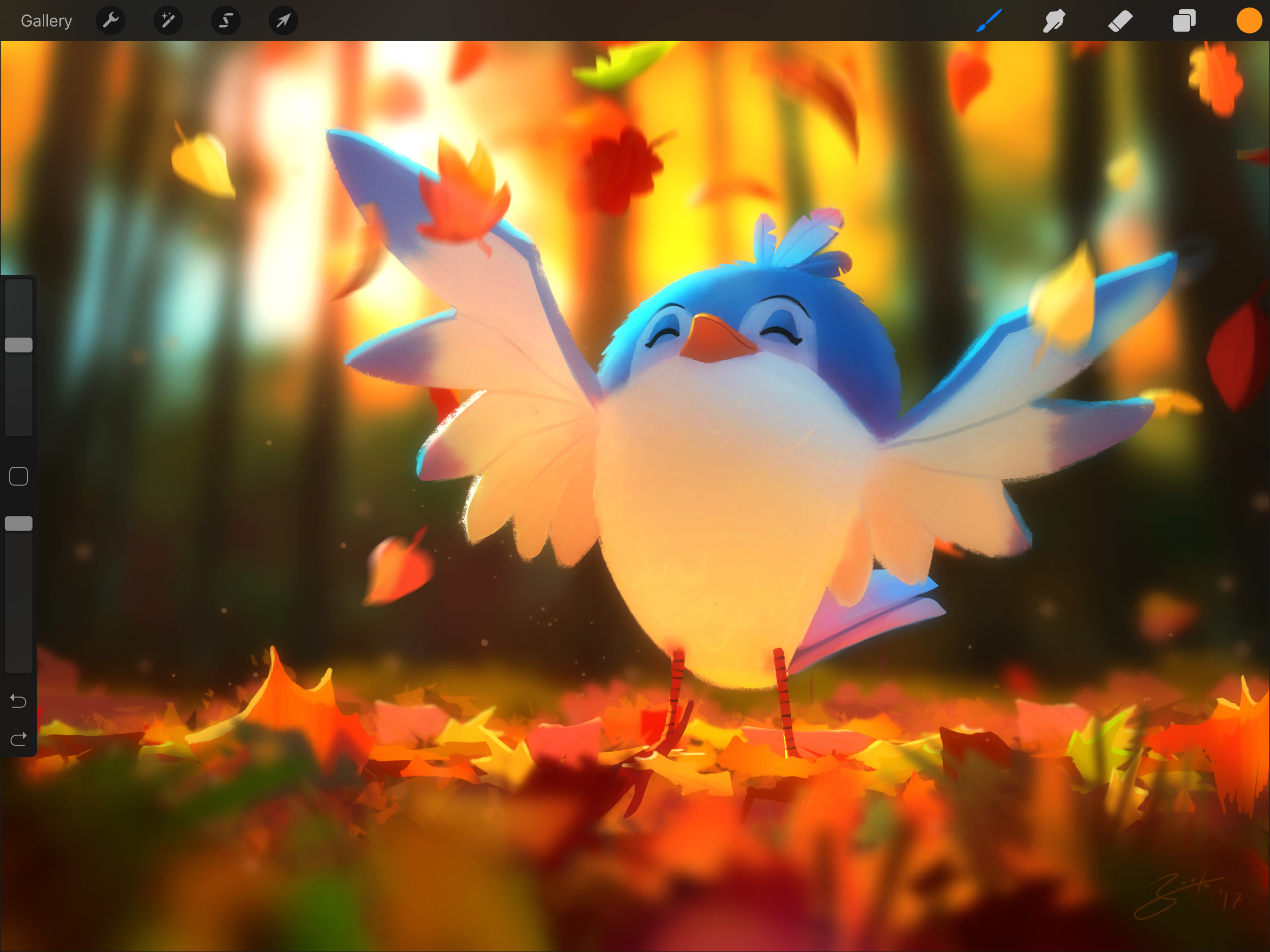
18 Comments
Alon Goldsmith
Loved this article! Well done Cara 🙂
Cara Gallardo Weil
Thank you so much Alon! xo
Catherine
Wonderful interview Cara!! Your work is amazing, and it was a pleasure to read about your artistic process. xoxo
Cara Gallardo Weil
Thank you so much Catherine! xoxo
Stef LP
Thanks for the introduction.
Another inspiring example of a mobile photographer that validates this venue.
Wonderful work Cara. And thanks for the tips.
Cara Gallardo Weil
Thanks Stef! and thank you for taking time to read the interview. 🙂
Lola Mitchell
Such wonderful photography and great interview! Very inspiring!
Cara Gallardo Weil
Thank you so much Lola! xo
Tracy Mitchell Griggs
Nice gallery. Interesting to see different part of the world.
Cara Gallardo Weil
Thank you Tracy! xo
Janine Graf
I can’t believe I almost missed this Cara (but you know how crazy life is right now)! I’m so in awe of you . . . xoxo
Cara Gallardo Weil
awww…. thanks Janine <3 Yes, I know about the crazy life! We're in the same boat! xoxo
MaryJane Sarvis
A wonderful interview with a very talented, intelligent and perceptive photographer. Cara, I love your sense of things for a myriad of reasons. Your blending of fine composition with your subjects, here focused on people mostly, is very powerful and finely considered. I’m a big fan and will always follow your travels closely. Bravo!
Cara Gallardo Weil
MaryJane thank you so much for your kind words – much appreciated. xoxoxo
Pingback:
Pingback:
Pingback:
クラークス 手入れ
iphone スピーカー bluetooth クラークス 手入れ http://www.lvsji.com/